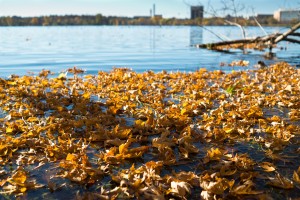by Dan Corcoran
It isn’t easy to solve a problem when the equation keeps changing.
That’s the case with Lake Mendota in Madison, a body of water that has continued to have issues with pollution over the last century with no solution in sight.
The problem
Simply put, the issue with Lake Mendota and the other three Yahara lakes – Monona,

Kegonsa and Waubesa – is that the amount of nutrients, specifically phosphorous, is too high. The phosphorous isn’t necessarily a problem by itself, but when it enters the lakes, it leads to issues for the organisms in the lake and visitors who use it.
Richard Lathrop, a research limnologist with the Wisconsin Department of Natural Resources who studies the Madison lakes, explained that the heavy flow of nutrients like phosphorous into Mendota results in increased productivity of the lake, which is known as eutrophication. That increased productivity leads to potentially harmful by-products.
“[The Yahara lakes] are eutrophic which means they’re excessively fertile and because of that we have blue-green algal blooms that are of human health concern,” Lathrop said. “The high level of nutrients in the lake is what we’re trying to cut back.”
The history
Trying to cut back the nutrients flowing into the Yahara Lakes is nothing new. As Lathrop discussed in one of his research studies from 2007, the unnatural eutrophication of the Madison lakes dates back all the way to the 1800’s.
According to the study, Lake Mendota didn’t start as the problem lake. Instead, it was Lake Monona, Mendota’s isthmus twin, which had wastewater pumped directly into it as early as the late 1800’s that began to sink its water quality.
Mendota’s water quality issues surfaced in the 1940s after World War II when wastewater from upstream communities as well as nutrients from agricultural sources in the Madison area began to increase.
But even with wastewater from those upstream communities coming to a halt in 1971, the problems with Lake Mendota’s polluted waters and poor water quality hardly subsided. And the issue that continues to plague Mendota and its Yahara counterparts is the same one that has caused troubles since the early 70s.
The problem is nonpoint source pollution, which is runoff from urban and agriculture sources. Surprisingly, that runoff actually resulted in higher levels of phosphorous in Mendota following the stoppage of the wastewater into the lake, according to Lathrop.
Despite nonpoint pollution reduction programs, which started around the same time, the blue-green algae that results from the eutrophication continues to be as much of a problem now as it was then.
More than one variable
It isn’t for a lack of effort that the issue hasn’t been solved.
There are a lot of things going on underneath the unusually stagnant waters of Mendota and in the surrounding ecosystem that have prevented a quick fix.
Global climate change has begun to complicate the situation, and it’s a stressor that doesn’t appear to be going away anytime soon, according to Lathrop. Although certain agricultural practices have managed to curtail the amount of sediment runoff, meaning a reduction in nutrient runoff, more frequent and magnified runoff events resulting from rainfall and snowmelt have essentially negated those practices in recent years.
And despite fewer farms around the Mendota watershed than there used to be, the amount of cows on farms in the area is more concentrated, according to Lathrop.
That leads to more manure and then greater concentrations of phosphorous in the soil. Coupled with climate change, the task of keeping nutrients out of the watershed much less cutting back becomes increasingly challenging.
“If you have more of them as a result of climate change, then the challenge for the future is just to keep up with the increasing number of runoff events,” Lathrop said.
Stemming the tide
The good news is that Lathrop and conservation organizations in the area know what must be done to clean up Mendota and the other lakes.
But it’s hardly a simple fix.
“There’s a consensus pretty much what we have to do. The challenge is actually doing it,” Lathrop said. “There’s a whole lot of agriculture out there. We’re trying to change how agriculture is being done. And it takes a lot of money to do that and it takes a lot of working with individual farmers.”
Lathrop has studied Mendota for the better part of 40 years now, and his research

indicates that Mendota can return to a healthy state with reduced levels of phosphorous input. This has been shown by drought years, especially by data in the 1980s.
Those drought years mean less rainfall and, in turn, less chance of nutrient runoff.
“The phosphorous levels in the lakes really drop,” Lathrop said of the drought years. “So it’s showing us if we could cut the non-point pollution, which is a tough problem, if we could cut it, the lakes would respond pretty quickly.”
But perpetual drought is hardly a possibility or a solution. The actual solution has to do with trying to control the amount of manure that accumulates on local farms, is spread on fields and often times runs off into the water.
“It’s a staggering amount of manure that we have to deal with,” Lathrop said. “You’re not going to put diapers on the cows and ship it out. You’re never going to stop it, but you really want to reduce it.”
An answer in the classroom
There are plenty of people trying to help clean up Mendota and solve the century-long issue.
Although it might not be in the most direct way, Scott Kloehn is one of those people.
Kloehn, who teaches environmental science and chemistry at Sun Prairie High School, originally graduated from the University of Wisconsin-Madison in 1999 with a double major in zoology and biological aspects of conservation.
Among his work as an undergraduate, his opportunities in the field of environmental science, which included research on Mendota, led him down the path of teaching and teaching in a subject area he had a passion for.
“I had this idea that I could make the work a better place and that’s why I went into teaching,” Kloehn said. “I knew that every year I was going to have the opportunity to change the minds of 100 or more students and so that’s ultimately why I became a teacher.”
Kloehn almost dropped out of school after his sophomore year, but found a flier one day that led him on a summer research opportunity to a lake in northern Wisconsin. It was hands-on scientific experiences like that one throughout the rest of his college career that helped him truly learn the subject matter.
Those experiences have stayed with him in his 13 years as a teacher, as he aims to inspire the next generation to do their part in conserving the environment around them.
“I had professors who despite my lack of academic achievement, saw something creative in me, saw a passion in me to want to study and be and behave like a scientist,” Kloehn said. “And they gave me graciously those opportunities to do that. And I’ve taken those opportunities and I’ve brought them into my classroom.
“Whatever small flame I took from UW-Madison and whatever small bit I passed along to the students here at Sun Prairie, a lot of them have run with that flame and igniting flames all over the place to be useful for the environment.”
One of those students just might be the piece needed to help solve Lake Mendota’s problems.
For more on this topic, click here.
